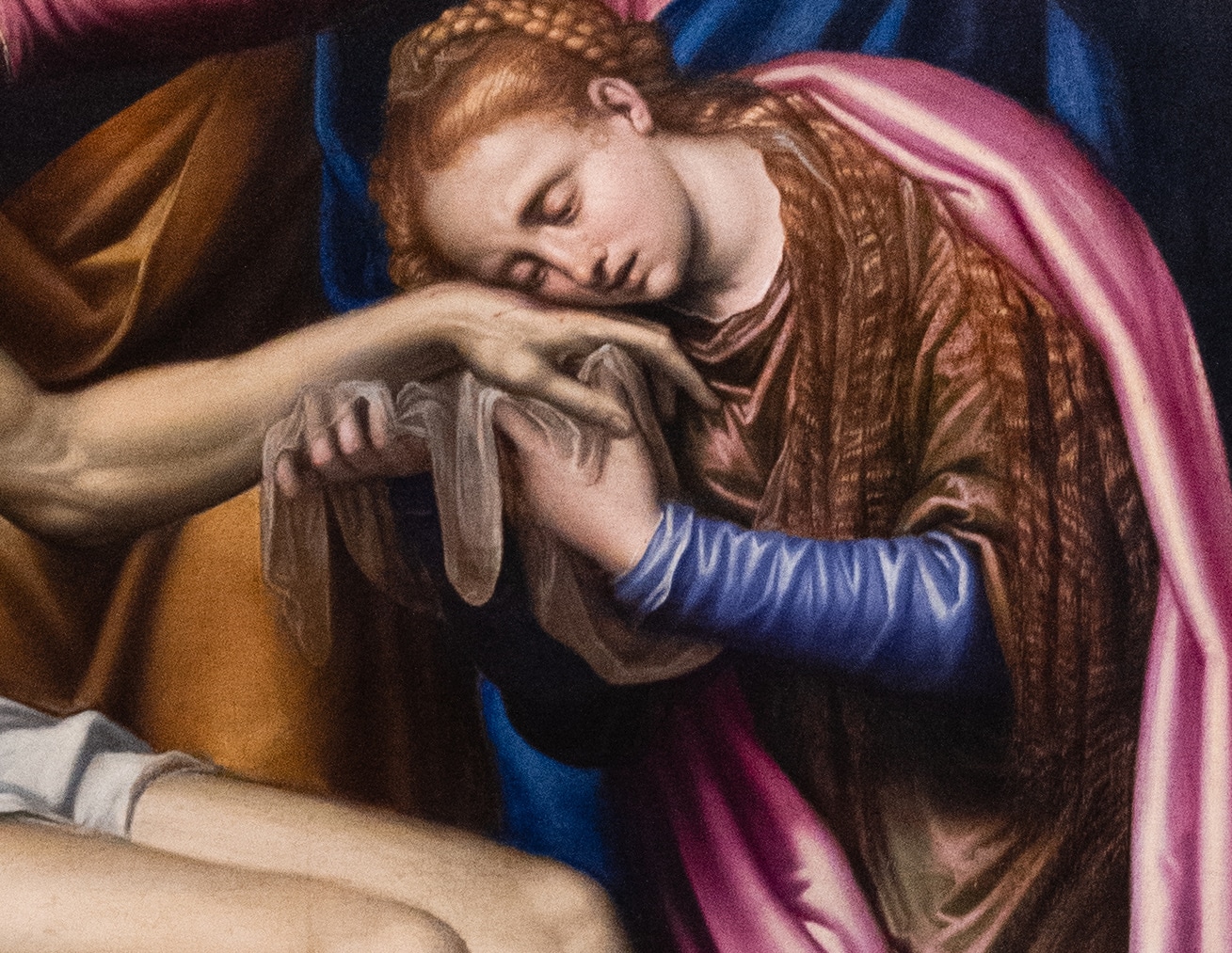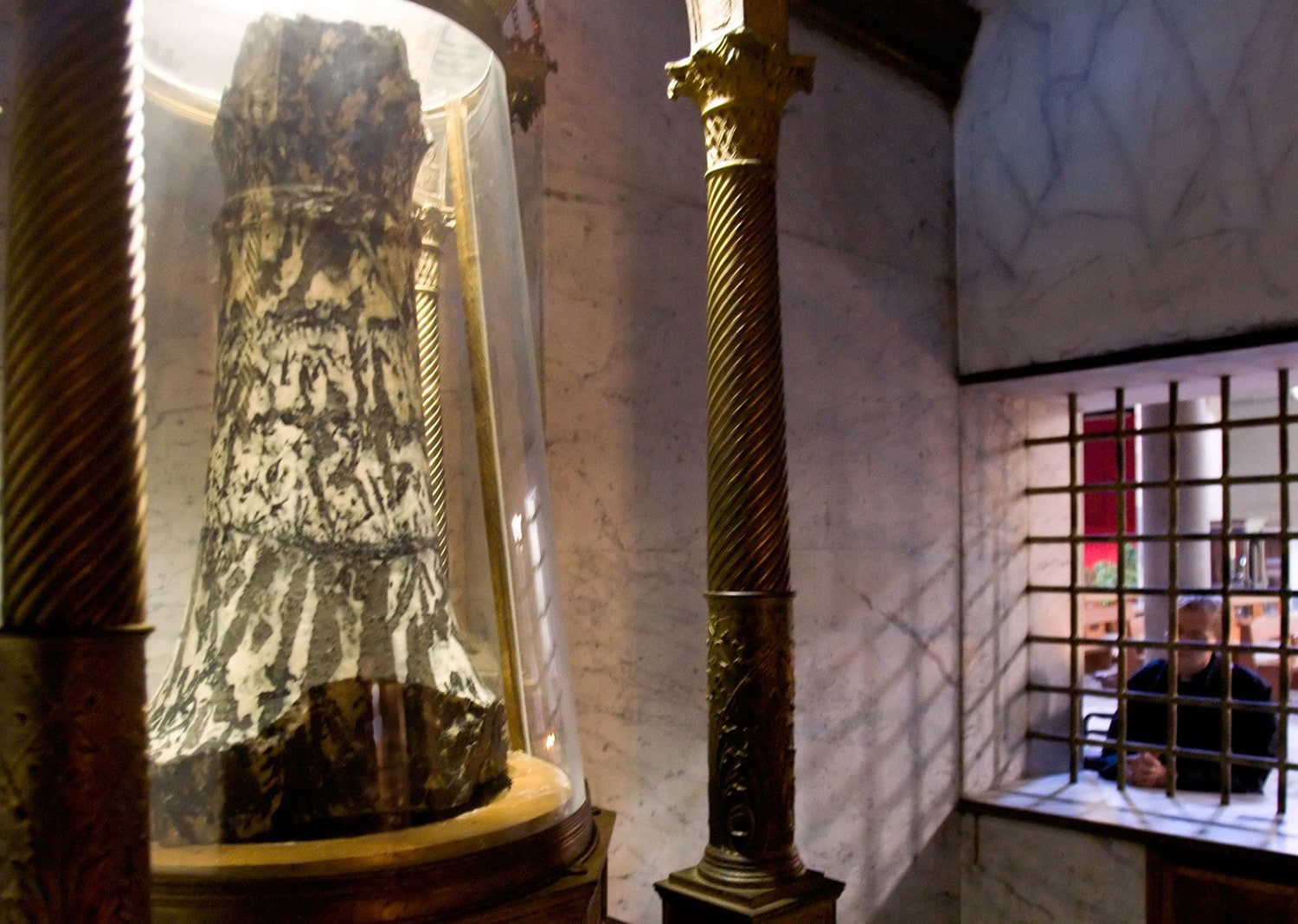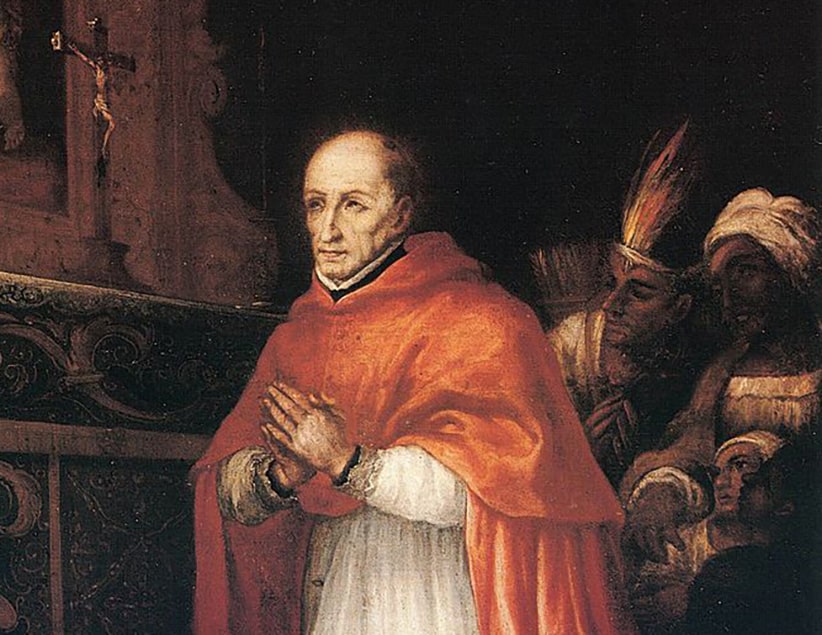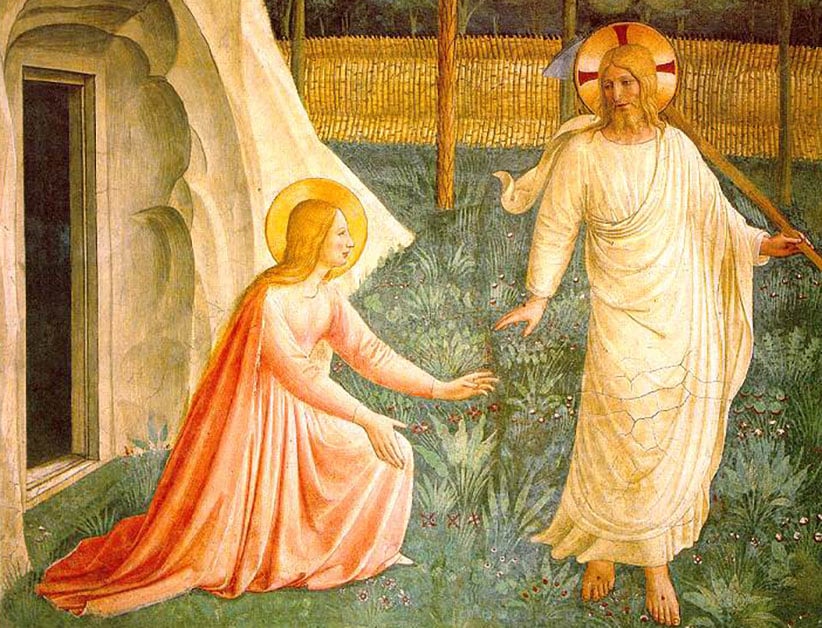Lent can be a bit of a challenge. So lately I’ve adopted the idea of walking through Lent with a particular saint. And for me, I’ll be honest, that saint is always Mary Magdalene. Not that I haven’t looked around, but when it comes to something as important as a guide who is an expert, why look further? From sinner to apostle, her life is a perfect trajectory of the season of Lent, from its penitential beginnings to its glorious conclusion.
An early friendship
She’s the best. Hands down, without question. And you might wonder how I came to that unbiased conclusion. It started about half a century ago. That sounds like a long time, but nuns have a different sense of time altogether, believe me. I was a 13-year-old Protestant girl from Lancaster, Pennsylvania, an incurable book worm and bored to tears one particular summer. My best friend, Christine, and I would spend hours in the downtown library, and that was the high point of our entertainment — apart from the new local mall, for which money was needed. Naturally we opted for the library where you can read for free and take it home with you. On one of these many visits, we came across an unusual book called “The Song of Bernadette” and another called “The Penitent” (about St. Maria Goretti). When I checked my junior high library for more of these books, I found a cream-colored hardcover with a red lily stamped on the cover. It was a novel about Mary Magdalene. OK, saint novels, especially about St. Mary Magdalene, are generally not that great, but this one was published by the St. Anthony Guild, making it relatively safe. That’s how it started. She was one of my first introductions to saints, and it stuck. And since I never liked anything by half, liking Mary Magdalene was no exception. I considered her my personal friend from this point on.
Magdalene was a wholehearted and fearless follower of Jesus. I wanted the same, and I needed someone to show me what that looked like.
The book was called “The Scarlet Lily.” It’s out of print, but even if it wasn’t, I wouldn’t recommend it. Although it was exactly what I needed at 13, trying to reread it 20 years later, I found it a bit schmaltzy and definitely not a future classic. Just the same, I’m most grateful to the author for the introduction to my saint. What I did learn from that book was the fact that Magdalene was a wholehearted and fearless follower of Jesus. I wanted the same, and I needed someone to show me what that looked like.
Really, it was these three saints, and Magdalene in particular, who were responsible for my 13-year-old-self deciding most adamantly — as only teenagers can do — that I was going to become Catholic. It was a simple logical conclusion in my mind. I read about these larger-than-life heroines and saw their stained-glass windows in the Catholic church across the street from where I lived. If they belonged to Sacred Heart Church, then that’s where I was going to go. I fully intended to be a heroine, too.
Magdalene’s conversion
In spite of that youthful decision, I still tend to approach Lent with a bit of trepidation, truth be told. It reminds me of the Catholic version of New Year’s resolutions, which I hate, for good reasons. I don’t enjoy feeling like a failure. I take a long time deciding on what the perfect renunciation is going to be, I start optimistically, and then comes the inevitable guilty feeling when it only lasts a day. Sound familiar? It’s a little like starting a diet and giving up after the first salad when we don’t see results. But it’s not just a Lenten resolution we’re making. And — this might come as a surprise to us — it’s not just for Lent! Unlike the great conversion of Mary Magdalene, most of us take baby steps in repenting. During Lent, however, the kind that’s called for isn’t just giving up chocolate or that first cup of coffee (not that these aren’t important). It’s a complete change in lifestyle, in choices, in desires, a major shift in focus. Changing that addiction, that something you can’t live without, into an obsession for God.
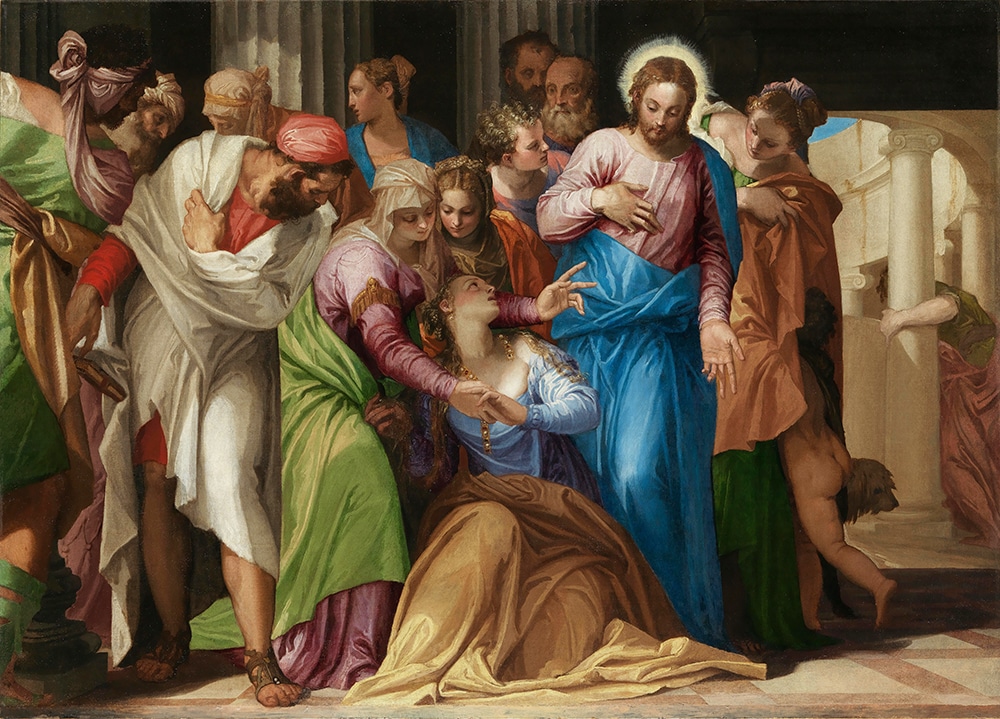
We don’t know Magdalene’s back story, not precisely in any case. What we do know is that she was friends with Joanna, the wife of King Herod’s steward Chuza (Lk 8:2-3). Which means she was most likely very well off, and she moved about in pretty dark circles. A wealthy Jewish woman in the court of Herod would get a reputation, and being possessed by seven demons wouldn’t be out of the question if you rubbed elbows with the likes of a bloodthirsty tyrant. “Tell me who your friends are, and I’ll tell you who you are,” as my grandmother was always fond of saying. But even without these details, we know that Magdalene was on a dark path. In her shrine in France, there is a hand carved image on the pulpit. It shows Jesus preaching and pointing authoritatively with his right hand at a woman dressed in fine clothes and jewelry, illustrating Magdalene’s first encounter with Jesus. Even though the scene isn’t in the Gospels, we do know it’s very possible that Magdalene at some point might have met the prophet who put Herod’s court into an uproar. And it’s also possible that, since John the Baptist was in Herod’s prison, she might have heard about Jesus directly from him.
There are very few people today who couldn’t identify with Magdalene’s early life pre-conversion. Her description as a young, wealthy woman — beautiful, curious, seduced by worldly promises, complimented by the people of the court, empowered by her beauty like a Jewish Cleopatra — could fit a lot of personalities in today’s world. Beauty, power, money, connections, popularity. It’s not like they ever went away. If anything, with social media they’ve gained a stronger foothold. But for Magdalene, the world only had so much to offer, and it soon left her hollow, bitter, empty and longing for someone to tell her the truth of who she really was.
If we find ourselves like Magdalene — disillusioned, dissatisfied, unhappy with where we find ourselves right now, wondering how in the world we let things go this far — then follow her lead. Because her next stop is at the feet of the One who can answer that question.
At the feet of Jesus
If we’re really paying attention, Lent has a habit of making us come face to face with ourselves. Reminded that we are “dust and to dust” we will return is an effective wake-up call, to say the least. Magdalene, being faced with the same reality, was overwhelmed with remorse, and ran to the only One who could truly restore her. This is the first time she appears in the Gospel in Luke 7:36-50.
Magdalene, who obviously didn’t care for public opinion to begin with, cared for it even less now that she knew this merciful Jesus, who she recognized as her only hope of salvation. Ignoring the stares and comments of the dignified, self-righteous men sitting at table with him, she fell at his feet in tears. Jesus, the “knower of hearts,” certainly knew the heart of the woman kneeling before him; broken, lost, wounded, disappointed by life and longing for true life. Magdalene, unbinding her glorious hair, covers his feet with her tears and kisses and then breaks the precious jar of perfume, emptying the nard down to the last drop. It’s almost as though all her love and longing were in that ointment, given to him in one audacious, extravagant gesture. His willing acceptance of her gift caused him to be the target of their murmuring as well. Really, “If this man were a prophet, he would know who and what sort of woman this is who is touching him, that she is a sinner” (Lk 7:39). So Jesus calls them out and stands on the side of the woman, telling them that although the Pharisees — sticklers for doing the proper thing — did not offer him the common courtesy of water for his feet, or a kiss of welcome, or oil for his head, this woman gave so much more. “So I tell you, her many sins have been forgiven; hence, she has shown great love. But the one to whom little is forgiven, loves little” (Lk 7:47). Leaving the Pharisees to wonder “who is this” who presumes to forgive sins, Jesus turns to Mary saying, “Your faith has saved you; go in peace” (Lk 7:50).
That first step was the beginning of Magdalene becoming St. Mary Magdalene. A sinner is basically a saint-in-training.
Advertisements
Remember “The Scarlet Lily” I talked about earlier? My memories of this Gospel scene go back even further than that. My grandfather bought me “The Golden Children’s Bible” when I was about 11, and my favorite page, my favorite story, was this one: the illustration showing a tearful Mary Magdalene, her abundant hair covering the feet of Jesus. To this day, I can recall the whole scene. It’s the image every time I go to confession — which, by the way, was never all that easy for me, growing up Protestant as I did. But since I wanted to be just like this heroine in the Gospel story, it has been my inspiration from then on.
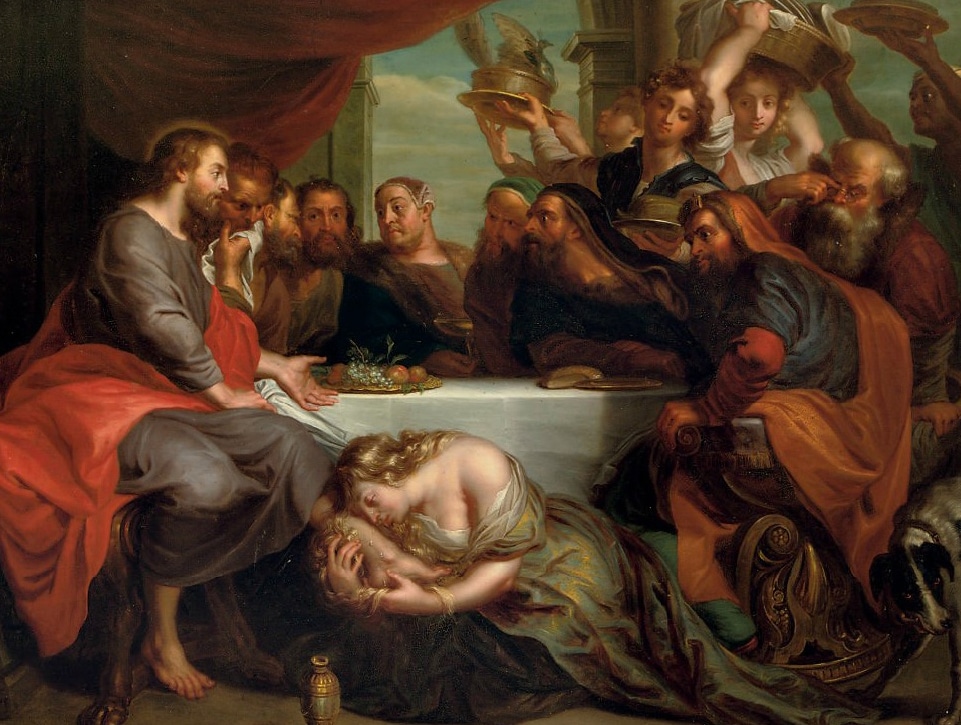
There are many people who line up for Communion at Mass. By comparison, there are very few who frequent the Sacrament of Reconciliation. But just as we encounter the real and living Jesus in the Eucharist, so, too, do we meet the merciful, forgiving Jesus in confession. The same One who looked with love and compassion on Magdalene at his feet waits for us in this sacrament. Some of us have a few of Magdalene’s sins, some have all or even more. But there is no one who doesn’t carry some burden of what they’ve done or what they’ve failed to do. The fact that there are more people in therapy today than ever before confirms it. We don’t hesitate to lay out the deep dark secrets of our past to the therapist, but a priest? Heaven forbid, right? The truth is, we have the courage to sin; what we lack is Magdalene’s courage to repent.
But that first step was the beginning of Magdalene becoming St. Mary Magdalene. A sinner is basically a saint-in-training. The Gospel tells us she wasn’t just a sinner but a rather notorious sinner, and it confirms that seven devils were expelled from her. What the Gospel also tells us is that her conversion didn’t stop there. There’s more to her story, just as there is to ours. So, take that step!
Meeting the “other” Mary
Another encounter that is not in the Gospel but happened, nonetheless, was Magdalene’s meeting with Jesus’ mother. At some point, Mary met Mary, since Magdalene subsequently became part of the group of women who followed Jesus and his apostles. There is also the well-known image of Magdalene standing with Mary at the foot of the cross, something that wouldn’t have happened if they weren’t very close to begin with. So, if you ask me, that meeting was inevitable, even if it’s not recorded. Can you imagine the difference Magdalene saw between the strikingly beautiful women in the court of Herod and the true, beautiful simplicity of the mother of Jesus? For her, it was a new kind of beauty that was standing before her; innocent, transparent, loving, welcoming. The same compassion and acceptance she saw in the eyes of Jesus, she now saw in the eyes of his mother. Mary Magdalene finally had the image of what perfection looked like in a woman, and I can’t imagine her ever leaving it behind.
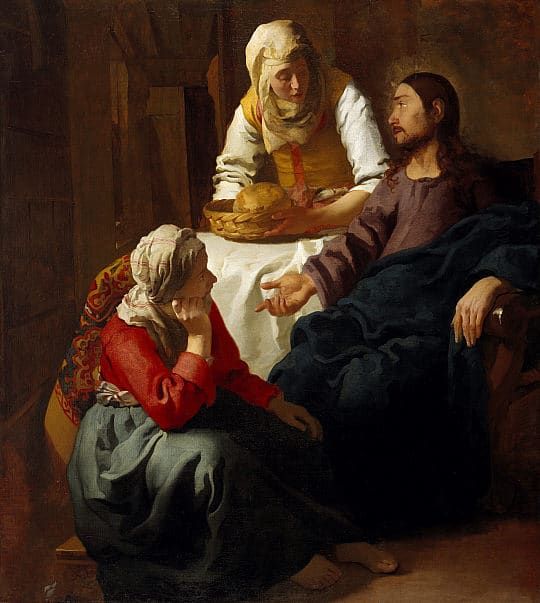
I remember my introduction to Mary. It was almost at the same time as my official introduction to the saints. At first, I was confused with how many “Mary’s” there seemed to be in the Catholic Church across the street from me. Lourdes was my first Mary-sighting, but there was also Carmel, Fatima, La Salette, Knock, Perpetual Help, Guadalupe, etc. It was a revelation when I was told it was all the same Mary. When you think about it, that’s pretty impressive. The Mary who stood before Magdalene is the same Mary who continues to come in search of her children in every country, through every century, in order to lead them to Jesus. We’re included in that search. Just as she welcomed Magdalene under her wing, she does the same for us if we let her.
I imagine Magdalene spending no little time with the Blessed Mother, to heal, first of all, but to learn from her as well. His mother was just the perfect model and “heroine” that Magdalene needed. Magdalene had made a mess of her life, thanks to mother-Eve, and now she had the incredible opportunity of spending time with Mother Mary, the New Eve, who would help her undo all the knots she had managed to make in her life. Watching and learning from this beautiful woman, Magdalene started to become what she admired. Mary listened to the words of her son and “kept all these things in her heart.” Magdalene started to do the same, and it transformed her.
Mary listened to the words of her son and “kept all these things in her heart.” Magdalene started to do the same, and it transformed her.
Lent is a time to slow it down, especially our thoughts. We’re so used to overstimulation and soundbites that the discipline of sitting still for 10 minutes seems like climbing the sheer face of El Capitan: impossible. Something we can try is to give at least (this is for starters!) 10% of the time we give to scrolling on social media and put it toward reading the Bible. So if you spend an hour mindlessly absorbing TikTok or Instagram posts, that would be 6 minutes devoted to Scripture. Be brave. You can do this! It’s the secret of the Blessed Mother. Magdalene learned from it, and so can you.
Eucharistic prophet
It might come as a surprise that some believe the Mary who had the bad reputation in Magdala was also the Mary of the “Martha, Martha” story, that is, Mary of Bethany. It makes sense since John’s Gospel even spells it out by saying: “Now a man was ill, Lazarus from Bethany, the village of Mary and her sister Martha. Mary was the one who had anointed the Lord with perfumed oil and dried his feet with her hair; it was her brother Lazarus who was ill” (Jn 11:1-2).
If you’re familiar with the story, Martha was playing the part of the quintessential hostess and was becoming increasingly annoyed with her sister, who couldn’t be moved from the Master’s feet. To the point that she complained directly to her guest, “Lord, do you not care that my sister has left me by myself to do the serving? Tell her to help me” (Lk 10:40). Credit to Martha for feeling so at ease with Jesus. Which is why he in turn could respond lovingly but just as bluntly, telling her that she was anxious and worried, but “Mary has chosen the better part and it will not be taken from her” (Lk 10:42).
There are more times in my life when I sympathized with Martha, to be honest. I wanted to be Mary, but it’s easier to identify with the woman who does too much, is always busy, always serving, always worried that everything must be perfect. In the meantime, while poor Martha is working up a solid resentment, there sits her sister enjoying the words of the Master, keeping him company. But really, nothing was stopping Martha from doing the same. It wasn’t an exclusive circle, so why not just keep him company along with Mary? Why not drop all the worries and focus all that energy on the One who is in your house and who came to see you and spend time with you?
Here’s where I think Mary is a veritable “Eucharistic prophet.” With so many other things clamoring for her attention, she puts them all aside because she understands what is the “one thing necessary.” He is the one thing necessary. He is the only thing that is absolutely essential. He is the One we can’t live without. She makes time for him. Exclusive, focused, loving time. After his own mother, Magdalene seems to be the first to recognize the importance of adoration. As Father Sean Davidson says in his wonderful book, “St. Mary Magdalene, Prophetess of Eucharistic Love,” “Very often the Real Presence of Christ in our churches meets the real absence of the faithful, but thankfully there are always a few souls who have the supernatural instinct of Mary Magdalene, to know that somebody ‘needs’ to be attentive to Christ wherever we still have the joy of his bodily presence among us.”
Don’t get me wrong, there are plenty of things that rightly do require our attention and so much pain in the world that just can’t be met with indifference. But to let fear and worry control our lives doesn’t make sense either, not when we have Jesus with us, just as he was in the home of Mary and Martha. He’s there to speak to our hearts, but he’s also there so that we can unload the cares of our hearts into his. Sometimes we can become experts at making excuses, but we always find time for what we want to do. If we can’t make an hour of adoration, we can make a short half hour visit, or at the very least spend a few quiet minutes after Communion at the end of Mass before jumping up to be first out of the parking lot. We have the time. What we’re often missing is the love.
So, to be a little more like Magdalene, we should take the advice of Father Pedro Arrupe and fall in love with God. It’s worth quoting and remembering:
“Nothing is more practical than finding God, than falling in love in a quite absolute, final way. What you are in love with, what seizes your imagination, will affect everything. It will decide what will get you out of bed in the morning, what you do with your evenings, how you spend your weekends, what you read, whom you know, what breaks your heart, and what amazes you with joy and gratitude. Fall in love, stay in love, and it will decide everything.”
Preparing for Holy Week
The first time Mary anointed Jesus, the Pharisees complained. At the second anointing at Bethany, it was Judas, one of the apostles, who complained (Jn 12:1-8). Both times she was censured for her extravagance, and both times Jesus came to her defense. The family of Bethany held a dinner for Jesus and his disciples after he had raised Lazarus from the dead. To show her love and gratitude, Mary took her costly nard, valued at more than a years’ worth of wages (300 denarii was about $54,509 U.S. dollars). But Jesus understood extravagant love, and like her master, Mary’s love didn’t calculate the cost but gave everything without a second thought. The whole room was full of people celebrating. Mary, who learned directly from his mother how to be attentive to Jesus, got up silently and came back with the ointment, not kneeling at his feet, but this time pouring it over his head. The perfume, like her heart, was very precious to the Lord, who knew her sincerity, just as he most certainly knew the betrayal that Judas was planning even then.
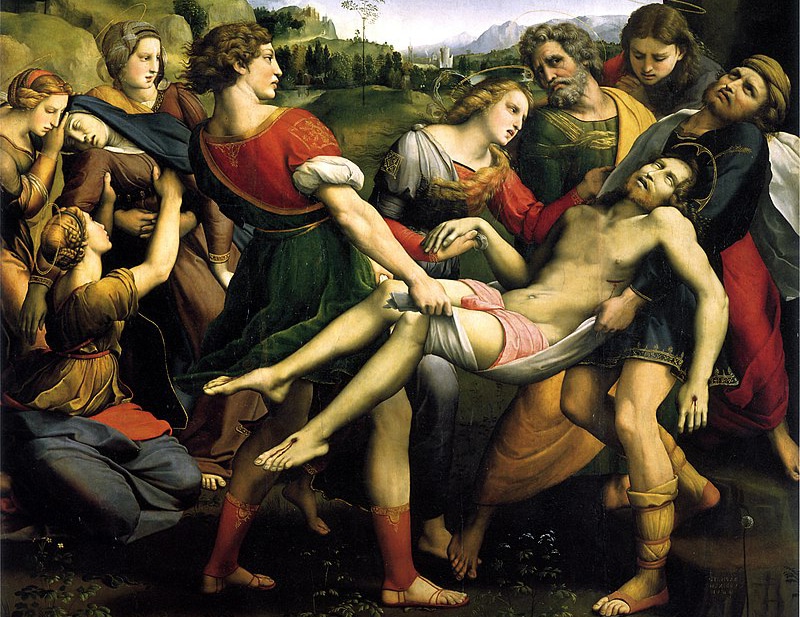
Imagine having Jesus defend you, and then finish by saying it was a beautiful thing you did for him, and wherever in the whole world the Gospel is preached, what you did would be told in your memory. Unexpected, that. And probably the last straw for Judas, who promptly made his way to the chief priests to betray him. That Gospel is worth a few meditations. Judas and Magdalene, both followers of Jesus, are polar opposites. Mary thought Jesus was worth every last drop of the perfume; Judas thought it was a waste. And he didn’t just think it, he said it out loud, which was almost like a slap in the face.
The time we spend with Jesus is a choice. We all have the same 24 hours at our disposal. How we “waste” it is entirely up to us.
Advertisements
“What a waste!” Knowing what was ahead of him in the next few days, I can only imagine how that remark must have made Jesus feel. A friend’s betrayal is no small thing, and that’s what Judas was: his friend and his apostle. But love that’s coerced isn’t love, and Jesus would leave him free even if his choices would break Jesus’ heart. But looking at Magdalene’s bold and generous act of love made all the difference at that moment. What a glorious, beautiful, prodigal waste she offered him. I once had some of that particular ointment on my hand from a prayer service in our chapel, and I could smell it for days afterward. So the smell of the fragrant spikenard (the whole jar) that Magdalene poured on his head was without a doubt still evident when Jesus began his passion. A reminder of all the broken souls he came to redeem and who would be willing to waste the whole precious jar of their love on him in adoration.
Going into Holy Week, I always think of the difference between these two followers, both chosen and loved by Jesus, and their individual responses to that love. The time we spend with Jesus is a choice. We all have the same 24 hours at our disposal. How we “waste” it is entirely up to us. But what an incredible thing if, at the end of our life, Jesus would look at us and say what he did in defense of Magdalene: “She has done what she could” and it was a beautiful thing (Mk 14:8).
At the cross with his mother
If Mary Magdalene had been in the garden of Gethsemane that fateful evening, I don’t think Jesus would have been left alone to face his impending passion. “So you could not keep watch with me for one hour?” would never have been said because she would have certainly done that and more (Mt 26:40). But that night, she was likely with another heavy heart: that of Jesus’ mother, who knew as only a mother could that something was about to happen to her child.
Although Magdalene had a love that was courageous, at that moment all she could do with that love was remain beside his mother in mutual support and grief at what was happening. And sometimes that’s all love, even the strongest love, can do: just stand by the loved one. From her conversion until that Holy Thursday evening, Magdalene’s love had only grown deeper for both Jesus and his mother. It was almost as if she was created and prepared precisely for this, to stand by Mary at the cross and to be a visible reminder to Jesus that he was still loved even in the midst of all the hatred that surrounded him. In every century, artists have tried to recreate the scene on Calvary, and in every work of art there is Magdalene, standing next to Mary and John the apostle. Two sensitive, loving, “Eucharistic” hearts next to the suffering hearts of Jesus and his mother. As Father Sean Davidson puts it: “The same Jesus who hung upon the cross and who received the love of Magdalene is now waiting to be loved in the Blessed Sacrament. Mary Magdalene knew she could not prevent the soldiers from mistreating Jesus, but she could love him and this love nobody could take from her. What the Church needs today above all, if we are to make up for the unceasing torrent of sacrileges and outrages that flood the sanctuary, are souls who know how to gaze like Magdalene into the eyes of the eucharistic Jesus” (“Prophetess of Eucharistic Love”).
So, every time we begin the Triduum, I feel I should put myself in their company. As the most important moment in the history of the world is played out, I don’t want to be a mere spectator; I want to stand next to Magdalene and John comforting Jesus’ mother and being with him to the end. It’s possible, because for God, time isn’t an issue. If we want to be there, we are there (and at every Mass, this is the reality of what is happening!). I also remember the impressive fact that there were only two “kisses” recorded in the Gospel: that of Magdalene when she kissed the feet of Jesus, and that of Judas in Gethsemane when he betrayed him. One is the antithesis of the other, and it’s almost as though the remembrance of Magdalene’s sincere love was a reparation in advance for the betrayal to come. And thankfully, for every Judas that appears in history, there is a Magdalene who is there to offer that love and reparation to Jesus’ heart. She was the first. Her mission in life was to love Jesus with a passionate, fearless heart, and this love would stand by him to the end. Now it’s our turn.
Apostle to the apostles
Do I have a favorite part of Magdalene’s story? I love them all, but I have to say, this one is worth waiting for. Most of us have felt a little of what Magdalene did in those hours after Calvary. I say little, because nothing could really compare to the devastating loss she felt at that moment, when hope itself seemed to be gone from the earth and there were no tears left to cry. But we’ve felt it, too — that wordless sorrow, that emptiness that hollows you out and leaves you a mere shadow of what you were. Despite all the terrible events of Good Friday replaying in her mind, she goes to the tomb with spices to finish the anointing that had to be ended so abruptly. What she finds is not what she expects. Two angels, one at the head and one at the feet, of where her beloved Jesus had last been seen. Were the angels reminding her of the two anointings and the consolation she had recently given to Christ? If so, Magdalene didn’t seem to notice or even acknowledge the angels. Still blinded by her grief, the angels had to ask her why she was crying. “They have taken my Lord, and I don’t know where they laid him” (Jn 20:13). Anyone who has ever lost a loved one can understand her pain — the kind of loss that leaves you missing half of your heart. A loss so total that it blinds you to everything, even to the beloved standing right in front of you. I love this paragraph from another favorite book:
“You stare ahead of you, and behind your back stands your Life! It calls to you, you turn around and cannot recognize it. Your eyes, unused to light, can grasp nothing. And then an abrupt word: your name! Your own dear name coming from the mouth of Love: your being, you’re very essence — yourself! — bounding from the mouth thought dead. … O word, O name, you, my own name! Spoken to me, breathed forth with a smile and a promise” (Father Hans Urs von Balthasar, “Heart of the World”).
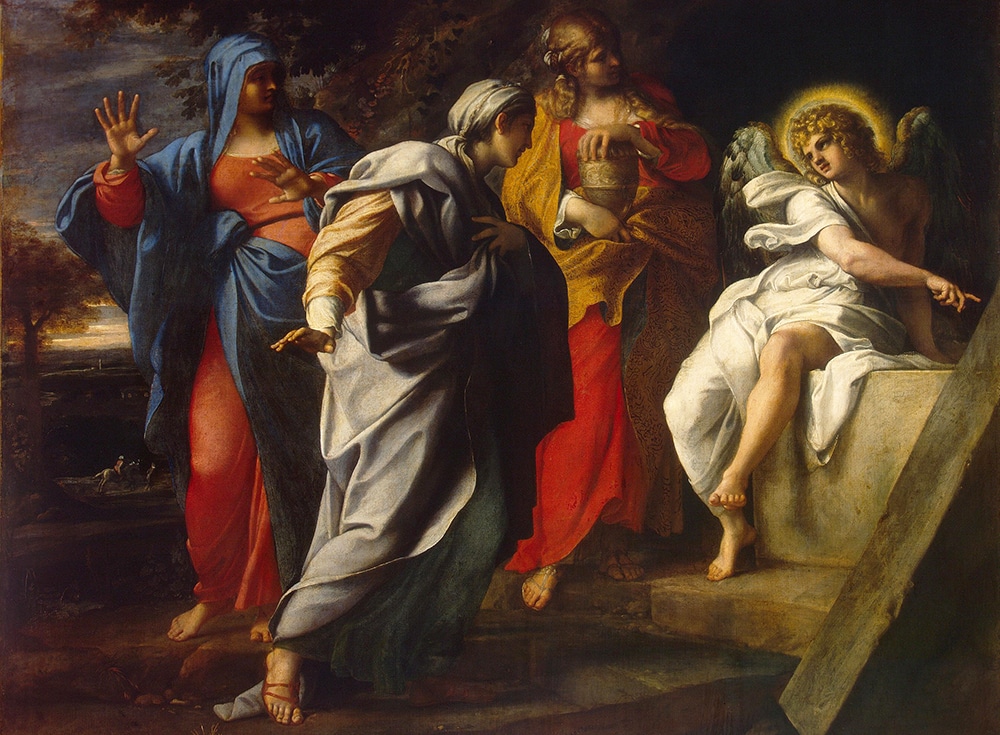
This is how we recognize him, too. So, on Easter day, be Magdalene and hear him call your name like that. “Your own dear name coming from the mouth of Love … breathed forth with a smile and a promise.”
Another voice interrupts her grief, asking, “Woman, why are you weeping? Whom are you looking for?” And sparks of the old Magdalene desperately, almost imperiously, demands of this gardener, “Sir, if you carried him away, tell me where you laid him, and I will take him.” And Jesus can’t seem to wait any longer and simply says to her, “Mary!” It’s only when she hears her name that she recognizes him (Jn 20:15-16)..
This is how we recognize him, too. So, on Easter day, be Magdalene and hear him call your name like that. “Your own dear name coming from the mouth of Love … breathed forth with a smile and a promise.”
Conclusion
Words fail me (at least concise ones) when speaking about this saint. What can you say about her? Mary of Magdala: freed of seven demons by the Lord, who anointed his head and feet with costly perfume, close friend of Jesus, disciple and supporter of his ministry, who stood next to his mother beneath the cross, who kept vigil at his tomb, who was the first witness of his resurrection, who was sent by Jesus to be the apostle to the apostles (who were still in hiding, by the way!), and who was in the Upper Room at Pentecost! That’s a lot and that’s just the bare bones.
A penitent woman. And a passionate, fearless apostle. A woman who basically ran through the gamut from sinner to saint like an Olympic champion. Halfway measures were not her style. She wasn’t a saint from the cradle; quite the opposite: Mary was a woman of the world who was broken, lost and hopeless, a sinner who was burdened with sin. And then she met Jesus. That’s the point of all this. She met Jesus and her life was never the same. And really, you and I are no different than her. It’s meant to be the same for us. Meeting him is everything. It’s what the Lenten journey to Easter is all about.
And that’s why Magdalene’s not just my favorite saint or my preferred Lenten companion. She’s a kindred soul, a teacher, mentor and sister. I watch her like she’s giving a master class in loving Jesus. My goal is to graduate with honors.

